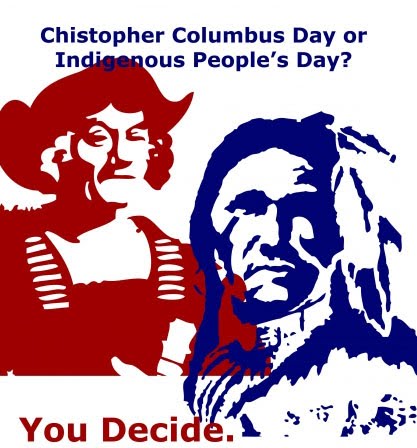Today offers coverage of the increasingly debated Columbus Day, the federal holiday whose history is excellently captured by NPR’s Lakshmi Gandhi. The Oatmeal offers an easy on the eyes comic to chronicle Columbus’ legacy.
In 1977 at the Conference on Discrimination Against Indigenous Populations in the Americas, the idea of replacing Columbus Day with Indigenous People’s Day first arose. In 1990, a Continental Conference on 500 Years of Indian Resistance took place, during which a resolution was passed to transform Columbus Day “into an occasion to strengthen our process of continental unity and struggle towards our liberation.” The first occasion of International Day of Solidarity with Indigenous Peoples took place October 12, 1992 and has continued since. Read more about the City of Berkeley’s (California) Indigenous Peoples Day.
John Curl, American historian and poet, writes of his poem, “Columbus and the Bay of Pigs”:
The struggle of the Taino people was not in vain. Today after 500 years the Indian nations are still resisting, although they still suffer injuries daily. The injuries they suffer, injure us all. Their struggle to survive is for us all. The indigenous people have never struggled only for physical survival, but for a way of living harmoniously with the planet. The Indian elders are correct when they say that the indigenous people are the caretakers of the world.The grandchildren of colonialism owe the native peoples an enormous debt. We are still just guests here, and should be humble. Only by joining with indigenous people in common struggle can non-native people ever hope to become at peace anywhere in this continent and build a constructive future.
The piece connects Columbus’ landing at the Bay of Pigs and subsequent destruction of a people to the U.S. imperialist conquests throughout the Caribbean in the 20th century. In doing so, he paints a picture of what was lost in this historic event. Excerpts from the poem below.
Imagine the sand of the beach called
Girón, fine and white, the big bend
that turns the corner of the Bay of Pigs,
Cuba.
Touch it. Take some in your fingertips.
Let it fall.
You are touching the blood of empire.
[…]
He [Columbus] hadn’t undertaken his “enterprise”
in the spirit of science,
but lusted for gold and power,
and sailed into the setting sun not just
to “discover” the Indies but
to conquer them.
[…]
To sum up the great profits of this voyage, I am
able to promise, for a trifling assistance
from your Majesties, any quantity of
gold, drugs, cotton, mastic, aloe, and as many
slaves for maritime service as your
Majesties may stand in need of.”
Those are the words of Christopher Columbus.
Yes, Columbus invented the slave trade
in the New World.
[…]
They had a myth – an old story, remembered
in many areitos – of how once a great cacique
named Guamiquiná, who wore
clothes and a beard, came down
from the sky in a ship,
from a place called Turey,
bringing precious gifts and teaching
the Taíno people many skills. Guamiquiná
could only stay a short while then
left, promising to return someday.
Was it any wonder then, when
Columbus appeared at these same shores,
the Taínos called him Guamiquiná,
expected him to stay only
a short while, and were shocked when
they realized that he didn’t plan
to leave at all?
[…]
Not long after,
the Christians caught him [Hatuey]
and tied him to a stake. A friar who knew
the Taíno language, told Hatuey,
just before they touched the flames,
“If you become a Christian, even now,
you will go to Heaven instead of
to the eternal torment of Hell.”
Hatuey asked the friar, “Do
all Christians go to Heaven?” The friar
said, “They do;” and Hatuey replied, “I
would prefer then to go to Hell.”
[…]
And so the island of Haiti-Bohío-Quisqueya,
which in Taíno means,
Mountain-House-Of Which Nothing Is Greater,
a land thriving with millions
of people when Columbus arrived,
within a short time was almost
depopulated.
And the beautiful Taíno language
became silence.
[…]
Who was this man Columbus?
The Taínos were not the only ones
with reason to hate the Governor:
a steady stream
of colonists returning to Spain
accused him of
abuse of authority, fiscal mismanagement,
withholding of salaries, embezzlement,
boundless personal ambition. Some rose
in the first colonial revolt in the New World,
in alliance with the Taínos,
led by Columbus’ former footman and squire,
Francisco Roldán, whom he in his wisdom
had appointed Chief Justice.
[…]
[…]
It was only the slave trade with Europe
that the king and queen saw fit to ban.
“Rebels” could still be enslaved, but had to be
kept in the Indies. When a Spaniard
was granted land, he was also “granted ”
all the Indians living on that land, as serfs:
this was the encomienda system
used to subdue all Spanish America.
[…]
But the U.S.A. was still hungry
for further domination, so turned south, and
by 1954 staged over 55 armed interventions
in Latin America.
Reblogged this on Truth Bomb Trails and commented:
“But the U.S.A. was still hungry for further domination, so turned south, and by 1954 staged over 55 armed interventions in Latin America.”